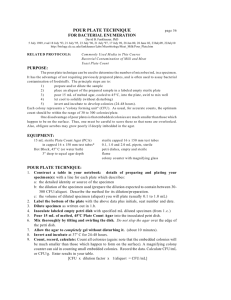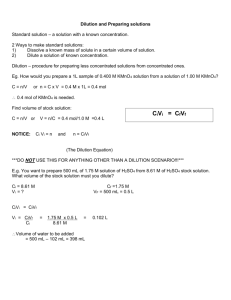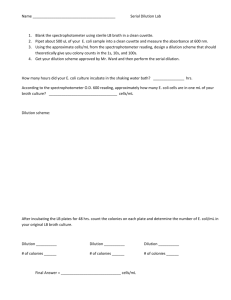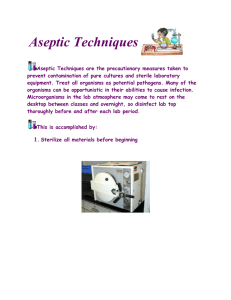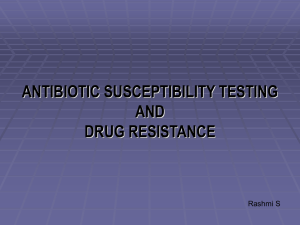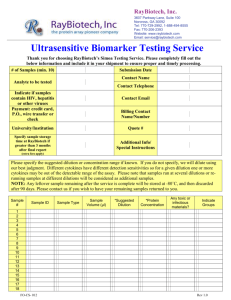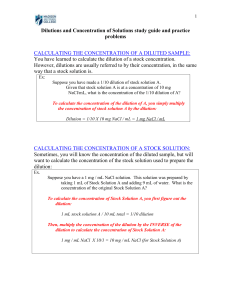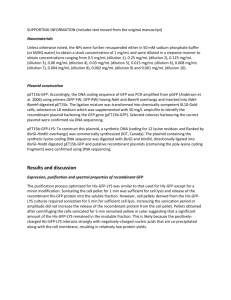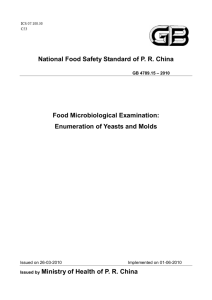Aseptic_Techniques
advertisement
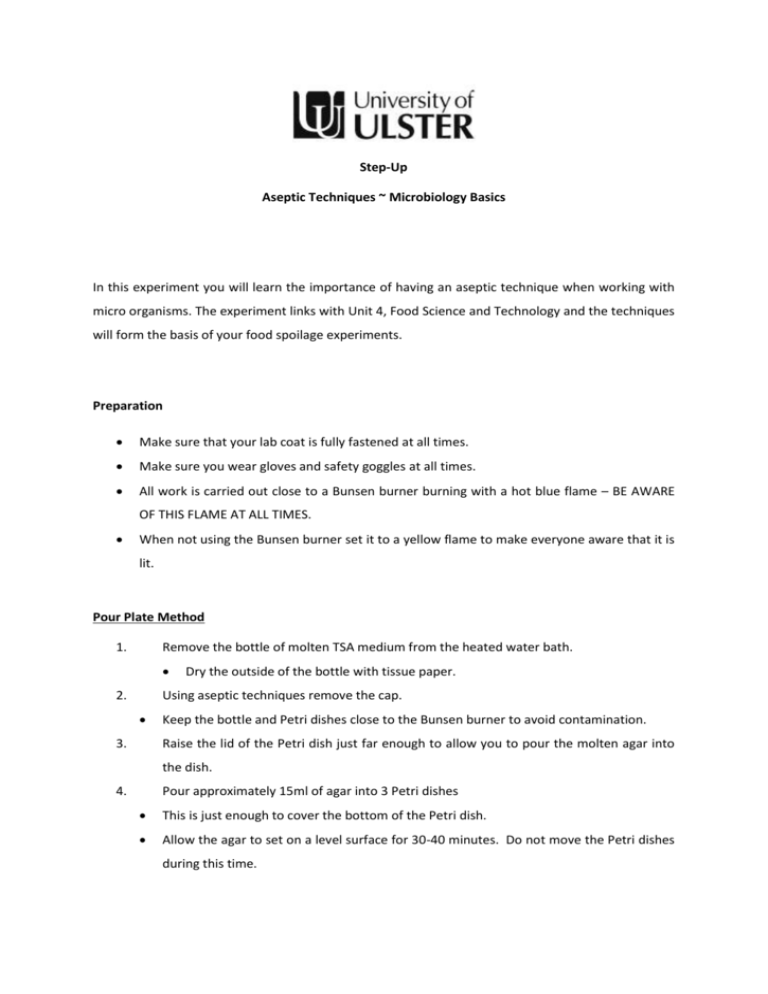
Step-Up Aseptic Techniques ~ Microbiology Basics In this experiment you will learn the importance of having an aseptic technique when working with micro organisms. The experiment links with Unit 4, Food Science and Technology and the techniques will form the basis of your food spoilage experiments. Preparation Make sure that your lab coat is fully fastened at all times. Make sure you wear gloves and safety goggles at all times. All work is carried out close to a Bunsen burner burning with a hot blue flame – BE AWARE OF THIS FLAME AT ALL TIMES. When not using the Bunsen burner set it to a yellow flame to make everyone aware that it is lit. Pour Plate Method 1. Remove the bottle of molten TSA medium from the heated water bath. 2. Dry the outside of the bottle with tissue paper. Using aseptic techniques remove the cap. 3. Keep the bottle and Petri dishes close to the Bunsen burner to avoid contamination. Raise the lid of the Petri dish just far enough to allow you to pour the molten agar into the dish. 4. Pour approximately 15ml of agar into 3 Petri dishes This is just enough to cover the bottom of the Petri dish. Allow the agar to set on a level surface for 30-40 minutes. Do not move the Petri dishes during this time. Serial Dilution Place 1g of food into 9 ml Ringers solution to create a bacterial suspension. 1. Take 1 ml of this solution and add to 9 ml of fresh Ringers solution to make 10-1 dilution. 2. Take 1 ml of 10-1 and add to 9 ml of Ringers solution to make 10-2 dilution. 3. Continue taking 1 ml and adding to 9 ml until 10-5 is reached. 1 ml 1 ml 10 -1 1 ml 10 -2 1 ml 10 -3 1 ml 10 -4 10 Bacterial suspension 1/10 1/100 1/1000 1/10000 1/10 Spreading Plates 1. Label agar plates on the bottom with 10-1, 10-2, 10-3, 10-4, and 10-5. 2. Make sure when opening agar plates that they are next to the Bunsen burner (sterile area). 3. Using a micro-pipette, draw up 100 µl from the 10-1 dilution and dispense it onto the surface of the 10-1 agar plate. 4. Use a sterile spreader (hockey stick spreader) to spread the sample across the plate. 5. Move the spreader back and forth whilst simultaneously turning the plate round until the whole surface is covered. 6. Plates should be spread at least in triplicate for each dilution. 7. Replace place lid, ready for incubation at 37oC for 24 hours. Bacterial Counts A viable count is only conducted on a plate with between 30 and 300 colonies on it. If a plate has more than 300 colonies on it, it is declared as having Too Many To Count (TMTC). Each colony is referred to as a Colony Forming Unit (CFU). 1. For plates with between 30 and 300 colonies, as the colony is counted, use a wax pencil to mark it on the outside of the plate. Make sure to count the colonies along the sides of the plate. 2. Average the number of colonies counted for each individual dilution. Dilution CFU Average CFU 10-2 280, 285, 290 285 10-3 31, 32, 33 32 3. Average counts from different dilutions by converting to the same dilution and then averaging. 10-3dilution x 10 = 10-2 dilution 32 x 10 = 320 Average of 320 and 285 = 303 CFU at 10-2 dilution 4. To calculate the total bacterial count i.e. the original concentration of bacteria, the average CFU is multiplied by the reciprocal of the dilution plated and the reciprocal of the no. of mls plated: Ave bacterial count x __1__ Dilution Factor x __1__ Volume loaded = CFU/ml e.g. 303 x __1__ 10-2 x __1__ = 0.1 ml 3.03 x 105 CFU/ml Gram Stain Method (determine Causative Agent) 1. Using a clean glass slide, place 10µl of sterile water in the centre of the slide. 2. Add 1µl of bacteria to the water and mix for form an emulsion and allow to air dry. 3. Heat fix the slide by passing the slide through a Bunsen Burner 3 times (Please use tongs!). 4. The remaining steps should be completed over the sink. Flood the slide with Crystal Violet and leave for 60 seconds. 5. Wash off Chrystal Violet with tap water for 10 seconds. 6. Flood the slide with Iodine solution and leave for 60 seconds. 7. Wash off Iodine with tap water for 10 seconds. 8. Flood the slide with 95% alcohol for 15seconds and tap off excess. 9. Flood the slide with Carbonyl Fusion for 30 seconds. 10. Wash off Carbonyl Fusion with tap water for 10 seconds. 11. Examine the slide using the microscope. Results:

